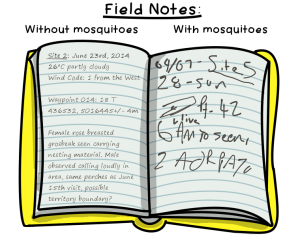We are excited to welcome the super-talented Liv Monck-Whipp to the blog today. Liv is the creator of Tails From the Field and write for us about how she uses humour to share her fieldwork stories. Make sure you check out her site – it’s hilarious!
It was shortly after getting attacked by a Ruffed Grouse in Algonquin Park that I decided to start making comics about fieldwork. I had been making my way out of the woods after monitoring some thrush and warbler nests, and I accidentally strayed into a mamma grouse’s domain. She did not take kindly to this (I am a big scary predator lookin’ thing, or at least so I like to tell myself), and while her brood flew hither and thither, she flew straight at my eyes. Luckily I was able to brush her off before she did any serious damage, and she set about buzzing by my head, perching on my shoulder to flap into my face. She continued her assault until she decided a broken wing display was more effective, and I thankfully escaped with my life. True story.
And my friends thought my dramatic re-enactment of this story was pretty hilarious. Much in the way so many of us gathered to guffaw around #fieldworkfail, stories of minor mishaps and equipment failing*, or weird study subject behaviour, if told with a dollop of humour, can be used to grab the attention and interest of non-fieldworkers and fieldworkers alike. And it’s not just the fails that amuse us. I know that you know that your field biology and/or naturalist friends have some of the cheesiest nature puns and jokes out there (and please send them all to me!). These are the product of true geekery – being so into your subject that you can’t help but inject it into everything with a grin.
That harrowing grouse encounter was pretty early into my field days. My second season out there, and I was starting to appreciate how hilarious field work could be. From the surrealness of explaining to my relatives that I couldn’t visit unless it was raining, to waking up covered in slugs, there were a lot of funny-weird, and funny-ha-ha things. And I loved it. And I wanted to communicate about how awesome it was.
I’m a web comic addict (often catching up on them once the field season is over!). So when I wanted to tell stories and in-jokes, I thought in comic-terms. Comics, if you think about it, are a really elegant way of delivering a story or idea in a short amount of time. They allow for the nuances of facial expressions, and the hyperbole of exaggerated figures to come through without using up text. The messages are usually quick, and humorous.
For my first few field seasons I was an assistant for graduate students working on bird and turtle studies out of Algonquin Park. Then I decided I wanted to do my own graduate work, and began studying bats in farmland. Somewhere in there, I worked for a large land trust doing conservation work, and I also got to radio track snakes and turtles for another study. This actually left me with a lot of “thinky” time in the field: hiking or canoeing long distances, or quietly getting eaten alive by mosquitoes while waiting for a bird to return to its nest. In this time I started to come up with comics and jot them down in my notebook**. Positive feedback from friends and co-workers convinced me that there would be a niche (geddit, geddit?!) for field work and ecology themed comics.
Laughter is a universal language. While I wanted to amuse others involved in field biology, I firmly believe that jokes and funny stories are some of the best ways to engage people about subjects you love, no matter their background. Humour can help to reduce the “stuffy scientist” image a bit, or lighten up an academic lecture. By sharing our sillier sides with each other and with the public we can gleefully spread our enthusiasm, and demonstrate just why fieldwork is so dang interesting.
So crack jokes in your talks, do that wacky impression of your study species’s mating call, and by all means, include that anecdote about “this one time we were out in the field and…”
*LET ME TELL YOU SOME STORIES ABOUT SETTING UP MICROPHONES TO AUTO-RECORD…
**Always have a notebook. Always.
Liv just finished her MSc at Carleton on the influence of crop arrangement and composition on bats. She did her BSc in Zoology at the University of Guelph, and then took off into the woods for awhile to assist in studies investigating nest protection for turtles, road mitigation for reptiles, and the effects of logging techniques on birds and vegetation communities. She also enjoys contributing to citizen science projects and is the creator of Tails From the Field, a web comic about field biology and nature.




I didn’t figure out what the title means until I’ve read the whole blog. Liv’s are sometimes very different from others.